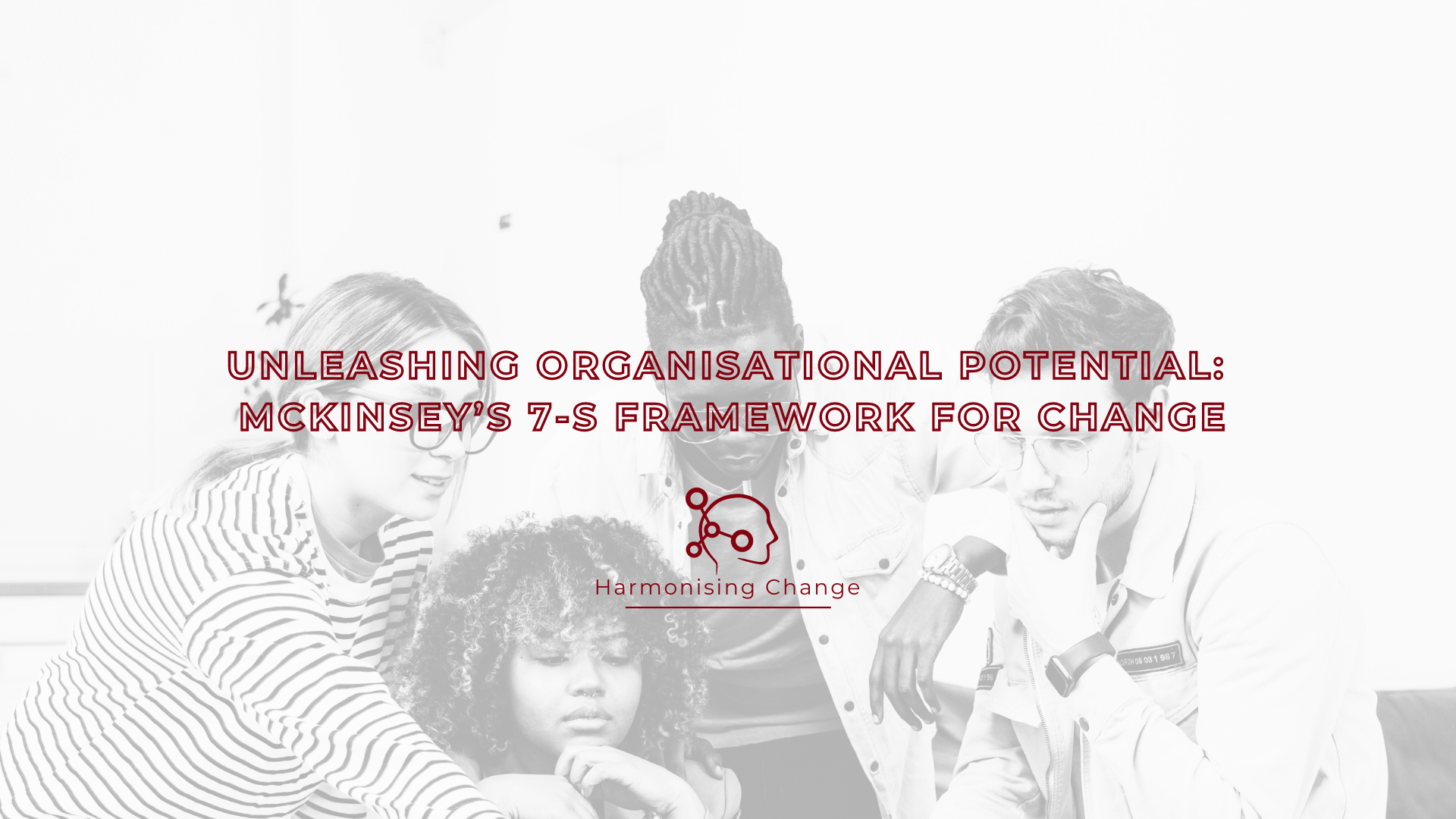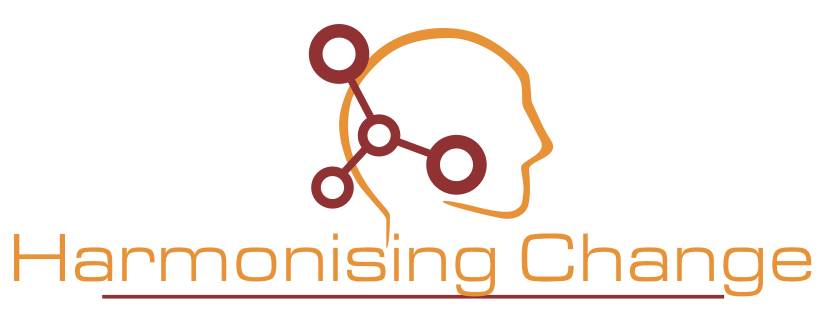
Unleashing Organisational Potential: A Deep Dive into McKinsey’s 7-S Framework for Change
In the world of organisational analysis and change, few tools wield as much influence as McKinsey & Company’s renowned 7-S Framework. At its core, the 7-S Framework embodies the essence of holistic change management, emphasising not only the tangible facets of an organisation but also the intangible nuances of culture and behaviour. This model serves as a cornerstone for organisations seeking to thrive amidst the winds of change.
Overview of McKinsey’s 7-S Framework
The 7-S Framework consists of seven interconnected elements that must be aligned and mutually reinforcing for an organisation to achieve its objectives. These elements are:
- Style: The leadership approach within the organisation.
- Skills: The capabilities and competencies of the workforce.
- Systems: The formal processes and procedures in place.
- Structure: The organisational hierarchy and reporting lines.
- Staff: The composition and roles of the workforce.
- Strategy: The organisation’s overarching plan and direction.
- Shared Values: The core values and goals that underpin the organisation’s culture.
Together, these seven elements provide a comprehensive framework for understanding and assessing the various dimensions of an organisation. The interconnectedness and interdependence of these elements highlight the complexity of organisational dynamics. Changes in one element can have ripple effects across the organisation, impacting other elements in unforeseen ways. By analysing each element individually and in relation to others, organisations can diagnose strengths, weaknesses, and areas of misalignment. This enables the development of targeted interventions and action plans tailored to the organisation’s specific context and challenges.
Style
Leadership style significantly influences organisational culture and can make or break change efforts. Leaders set the tone for how change is perceived and embraced by the workforce. For instance, a participative leadership style that encourages input and collaboration can foster a more inclusive and adaptive culture. In contrast, an autocratic style may stifle creativity and resistance to change.
Leadership Styles
- Servant Leadership: Focuses on empathy, humility, and service to others, prioritising the needs and development of team members.
- Transactional Leadership: Involves setting clear expectations, structured rewards, and consequences for performance, driving efficiency and accountability.
- Transformational Leadership: Inspires and mobilises teams towards a shared vision, fostering innovation, adaptability, and continuous learning.
- Situational Leadership: Tailors behaviours and strategies to suit the demands of the situation and the needs of followers, embracing ambiguity and complexity.
- The impact of leadership behaviour on organisational change is profound, shaping not only the trajectory but also the outcome of change initiatives. Leaders serve as architects of change, shaping the narrative, setting the direction, and mobilising resources to realise strategic objectives.
Skills
The skills and competencies of the workforce are critical in achieving organisational goals, especially during times of change. Assessing current skills and identifying gaps is essential for successful change management. This can be achieved through training programs, upskilling initiatives, and continuous professional development.
Key Components
- Skills: Tangible abilities acquired through education, experience, and practice, enabling task execution with precision.
- Competencies: A broader spectrum of attributes, including knowledge, attitudes, and behaviours, contributing to successful job performance.
- Capabilities: The unique blend of skills, knowledge, values, and processes that enable organisations to innovate, adapt, and excel.
By understanding and nurturing skills, competencies, and capabilities, individuals and organisations can enhance performance, foster development, and achieve strategic ambitions.
Systems
Systems encompass the formal processes and procedures that govern daily operations. Effective systems streamline workflows, reduce redundancies, and enhance efficiency. During change initiatives, reviewing and optimising these systems can remove obstacles and facilitate smoother transitions.
Optimising Systems
A thorough examination of formal processes and procedures can uncover opportunities for improvement and optimisation. This may involve streamlining workflows, eliminating redundant steps, or implementing new technologies to automate manual tasks. By continuously refining and updating these systems, organisations can enhance operational efficiency, minimise errors, and maintain a competitive edge.
Optimising systems can be instrumental in supporting change management initiatives within an organisation. Well-designed systems can help facilitate a smooth transition and minimise disruptions to daily operations.
Structure
The organisational structure defines roles, responsibilities, and reporting lines. An effective structure supports strategic objectives and facilitates communication. However, rigid structures can impede change by creating silos and reducing flexibility.
Organisational Hierarchy
In hierarchical structures, communication and decision-making flow down from top management to lower-level employees. This top-down approach can be effective for disseminating information and ensuring consistency in decision-making. However, it can also lead to resistance to change if lower-level employees feel disconnected from the decision-making process.
Reporting Lines
Clear reporting lines can ensure that information about change initiatives reaches all relevant stakeholders in a timely and consistent manner. However, rigid reporting structures may impede communication and collaboration, making it difficult to adapt to changing circumstances.
Successful Restructuring Examples
- Google: Functional structure with departmental specialisation, fostering collaboration and knowledge sharing.
- SpaceX: Project-based structure with cross-functional teams, accelerating innovation and continuous improvement.
Staff
The workforce is the engine driving organisational change. Understanding the composition of the staff, their strengths, and areas for improvement is vital. Managing staff dynamics, including morale and motivation, can significantly impact the success of change initiatives.
Workforce Composition and Dynamics
- Demographic Patterns: Blending generational cohorts to foster collaboration and innovation.
- Technological Trends: Embracing digital tools and platforms to drive organisational success.
- Economic Globalisation: Navigating diverse talent pools and fostering inclusivity.
- Diversity Factors: Including race, ethnicity, disability, gender identity, and socioeconomic status.
By delving into the intricate makeup of the workforce, companies can gain insights into employee roles, demographics, and diversity, enabling informed decision-making and strategic planning.
Strategy
A clear, well-defined strategy aligns all elements of the organisation towards common goals. The strategy should be communicated effectively to ensure that all employees understand their role in achieving these objectives.
Importance of Business Strategies
- Clarity of Vision and Direction: Translating aspirations into actionable steps.
- Identification of Strengths and Weaknesses: Enhancing efficiency and effectiveness.
- Comprehensive Planning and Resource Allocation: Ensuring better resource allocation and utilisation.
- Competitive Advantage and Differentiation: Positioning as leaders in respective industries.
- Operational Control and Execution: Ensuring alignment with predefined objectives and milestones.
Strategic alignment enables organisations to make informed decisions, prioritise initiatives, and foster organisational agility and adaptability.
Shared Values & Goals
Shared values are instrumental in shaping organisational culture, providing the guiding principles that influence behaviour and decision-making across the organisation. Also known as core values, these fundamental beliefs define the organisation’s identity and brand.
Importance of Shared Values
- Common Direction: Guiding decision-making and behaviour.
- Unity and Belonging: Fostering a positive work environment and improving teamwork.
- Differentiation: Attracting and retaining employees and customers who resonate with those values.
- Ethical Behaviour: Preventing unethical behaviour and enhancing the organisation’s reputation.
Shared values and goals are vital components of organisational culture, guiding behaviour, fostering unity, differentiating the organisation, and promoting ethical conduct.
Practical Application Tips
- Assessment: Regularly assess each element of the 7-S Framework to identify misalignments.
- Communication: Foster transparent and frequent communication to keep all stakeholders informed and engaged.
- Involvement: Involve employees at all levels in the change process to enhance buy-in and reduce resistance.
- Flexibility: Be prepared to adapt strategies and structures as needed to respond to new challenges and opportunities.
Conclusion
McKinsey’s 7-S Framework provides a comprehensive approach to organisational change management. By understanding and aligning the seven elements—Style, Skills, Systems, Structure, Staff, Strategy, and Shared Values—organisations can navigate change more effectively. Embracing the interdependence of these elements ensures a holistic approach, unleashing the full potential of the organisation for sustained success.
Contact Harmonising Change here.



